Creating Prototypes Is Required For Invention Success!
You can credit most inventors success to three things:
- Evaluating their idea concept
- Creating prototypes
- Effectively marketing their invention
This article covers how creating prototypes of your invention can give your idea life, direction and credibility.
Seeing your invention in the physical form of a prototype is an exciting part of the invention process. Excitement aside, it is also the best way to determine the likely success of your idea. Prototypes help to:
- Give your idea credibility
- Give users something concrete to evaluate
- Determine how your product will be manufactured
- Determine the cost of your finished product
By creating prototypes of your invention you will find out many of the small but usually non obvious things that are important to make your invention work. When I have an invention idea the first thing I do is evaluate that idea with a competitive product search and patent search. Once I am confident the idea is unique, useful, and shows enough potential to proceed I will build a prototype.
Creating prototypes does not have to be a complicated or difficult process. I put prototypes in three categories. They include:
- Crude Working Prototypes
- Aesthetic Prototypes
- Pre Production Prototypes
These various prototypes are created for different reasons and are valuable in different ways.
Crude Working Prototypes:
Crude working prototypes are the most important for your initial evaluation of your idea. These prototypes allow you to test your idea for its function and use ability. Often the way you think something is going to work doesn't. By finding out what does not work, your idea will evolve and become better.
Crude prototypes can be built by modifying existing products and adding that something extra that makes it your invention. You can also use common items found at a hardware store to build your model. The idea is build a prototype that tests your concept. You can build it out of wood and glue, foam and pipe cleaners or get more fancy if you have the tools. The idea is to create something so you can get some feedback. Feedback from your own use and the use of others.
Many times when I have an idea I will go into my shop and look around for ways to cobble the things I have on hand together into a prototype. One recent example is when I used plastic tubes, old bungee cords and hot glue to make a new shooting toy I was developing. I was able to cobble together the parts in about 20 minutes and build a fully functioning model.
Many times just going through this process will stimulate your thinking and help you overcome the small problems that are always present with a new idea.
A great way to develop crude prototypes is with prototype machining. To learn more about the different machining processes <>.
The point is to build something, no matter how ugly, that gives you the confidence to move forward.
Aesthetic Prototypes:
Aesthetic prototypes are the opposite of crude prototypes. By definition they look good. They do not necessary have to function however. Their purpose is to give you, your investors, retailers etc. an idea of what your product would look like when it is for sale on a retail shelf somewhere. They usually look good, feel, feel good and are painted giving the impression of a product that is ready to sell.
These can be useful for taking photographs for marketing materials or testing with focus groups.
As an inventor, the very first aesthetic prototype that I ever built was for a power tool that I and a partner developed. We were new to the game of invention marketing and ended up spending over $10,000 dollars for a beautiful, nicely painted non working model. We ended up using the model in our product photos, but not much else. Although I rarely recommend spending that kind of money on an aesthetic model anymore, it proved to be valuable to us at the time. More on this later.
Pre Production Prototypes:
The final category of prototypes are pre production prototypes. This is a real version of your product in very small quantities, usually 1-3. Most of the time these types of prototypes are created using rapid prototyping techniques based on 3D product design. These prototypes allow the invention concept to become perfected before proceeding to manufacturing. They look very similar to real products in the same way Aesthetic prototypes do, but they also function like the actual product.
The bottom line when it comes to spending money on prototypes is to only spend what is required to get the result you are looking for. That is why it is so important to educate yourself on what is required for your industry, product type and the marketing approach you are taking.
If you want to be successful with your invention, creating prototypes is a necessity. There are many types of prototyping process and prototype makers. Click here to learn about prototype makers.
Recent Articles
-
Don't Dare Underwear
Jun 19, 24 11:03 AM
I created a new concept of the boxer briefs with the pocket. They are specifically designed to carry a condom. Joining the fight against infectious diseases -
Rol-A-Flex: Platinum Edition
Apr 08, 24 11:24 AM
Hi My Name Is Malcolm Washington, I'm 19 Years Old And My Invention Is A New And Important Rol-A-Flex AB Belt Called Rol-A-Flex Platinum Edition, It's -
SENSE AWARE
Mar 26, 24 08:00 AM
Sense Aware represents the latest assistive technology project designed to improve safety and independence for the disabled. At its core is the Arduino

